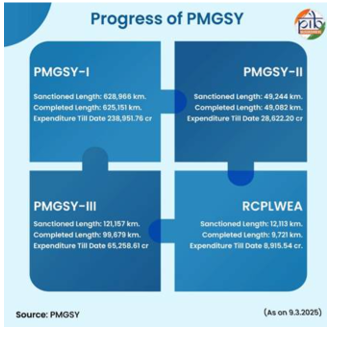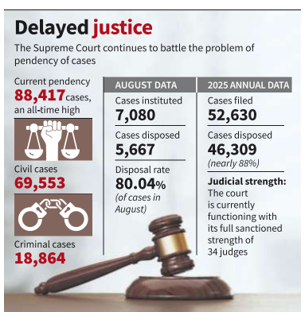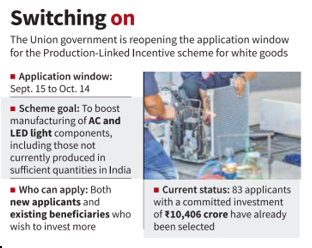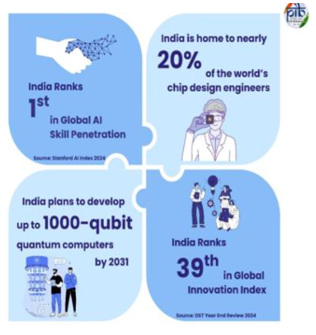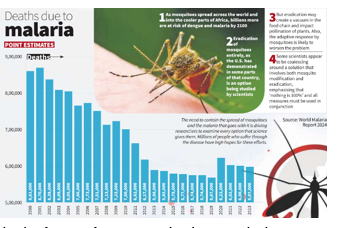

15th September 2025 (15 Topics)
Mains Issues
Context
As of August 2025, PMGSY has sanctioned over 1.91 lakh rural roads and 12,146 bridges, strengthening connectivity and socio-economic development in remote areas.
Bridging Rural Isolation Through Infrastructure
Introduction
- PMGSY, launched on 25th December 2000, is a flagship programme aimed at providing all-weather road connectivity to unconnected rural habitations.
- Roads enhance access to markets, healthcare, education, and employment, fostering inclusive socio-economic growth.
- Example: In Madhya Pradesh, the construction of a bridge over Rojhan Nalla enabled 2,000 villagers—mostly SC/ST—to access schools, hospitals, and markets safely, generating nearly 3,000 days of employment during construction.
Objectives of PMGSY
- Ensure all-weather connectivity for unconnected habitations.
- Improve rural livelihoods through better access to markets and services.
- Promote socio-economic development in backward, tribal, and LWE-affected regions.
- Facilitate inclusive development and poverty alleviation in rural India.
Phases and Progress
- PMGSY Phase I (2000)
- Focused on connecting eligible unconnected habitations.
- As on 31 July 2025: 1,63,339 habitations sanctioned; 1,62,818 (99.7%) constructed.
- PMGSY Phase II (2013)
- Upgradation of existing rural roads for economic and transportation efficiency.
- Road Connectivity Project for LWE-Affected Areas (RCPLWEA, 2016)
- Targeted 44 LWE-affected districts in 9 states.
- Objectives: support anti-LWE operations and provide socio-economic upliftment.
- PMGSY Phase III (2019)
- Consolidation of through routes, farm-to-market links, and connections to higher secondary schools, hospitals, and Gramin Agricultural Markets.
- Facilities connected:38 lakh GAs, 1.46 lakh educational centers, 82,000 medical centers, 3.28 lakh transport/other facilities.
- PMGSY Phase IV (2024–29)
- Target: connect 25,000 unconnected habitations.
- Proposed road length: 62,500 km; total outlay: ?70,125 crore.
- Special focus on tribal, desert, and aspirational districts.
Use of Technology and Green Initiatives
- Green Construction Technologies
- Adoption of eco-friendly materials: fly ash, slag, waste plastic, crumb rubber-modified bitumen, bamboo crash barriers, geosynthetics, etc.
- 1,66,694 km sanctioned using green technology; 1,24,688 km completed as of August 2025.
- Digital Monitoring and Maintenance
- OMMAS: real-time monitoring of physical and financial progress, quality checks via Project Management Information System (PMIS).
- e-MARG: performance-based maintenance contracts, ensuring long-term durability.
- GPS Vehicle Tracking System: mandatory for construction machinery since May 2022.
- Three-Tier Quality Monitoring
- Tier 1: Field-level checks by executing agency.
- Tier 2: Independent State Quality Monitors (SQMs).
- Tier 3: Surprise inspections by National Quality Monitors (NQMs).
Integration with Social Development Initiatives
- Dharti Aaba Janjatiya Gram Utkarsh Abhiyan (DA-JGUA):
- Holistic development of tribal communities; PMGSY-IV ensures road connectivity for habitations with high ST population.
- Pradhan Mantri Anusuchit Jaati Abhyuday Yojana (PM-AJAY):
- Targets SC-dominated habitations for socio-economic upliftment and infrastructure access.
- Pradhan Mantri Janjati Adivasi Nyaya Maha Abhiyan (PM-JANMAN):
- Road connectivity component: 6,506 km sanctioned to connect 2,636 habitations of Particularly Vulnerable Tribal Groups (PVTGs).
Impact on Rural Development
- Economic Access: Easier transport of agricultural produce, better market prices, employment generation.
- Social Upliftment: Improved access to healthcare, education, and government schemes.
- Inclusivity: Special focus on SC/ST communities and vulnerable groups.
- Environmental Sustainability: Use of green construction technologies contributes to SDGs, including poverty reduction and climate resilience.
Way Forward
- Enhanced Use of Technology: Integrate AI and GIS for predictive maintenance and traffic management.
- Community Participation: Encourage local employment and skill development during road construction and maintenance.
- Sustainability Focus: Expand the use of renewable and recycled materials in rural roads.
- Monitoring & Evaluation: Strengthen real-time quality checks and periodic post-construction audits to ensure durability and economic benefits.
- Inclusive Planning: Prioritize connectivity for habitations in remote, tribal, LWE-affected, and aspirational regions to achieve equitable growth.


Mains Issues
Context
World Environment Day 2025 (June 5) focused on “Ending Plastic Pollution,” highlighting its environmental, socio-economic, and health impacts.
Understanding the Challenge of Plastic Pollution
Scale and Severity of Plastic Pollution
- Global Trends
- OECD’s Global Plastic Outlook:
- Plastic production doubled from 2000 to 2019 (460 million tonnes).
- Waste generation reached 353 million tonnes.
- 500 million tonnes of plastic produced/used in 2024, generating ~400 million tonnes of waste.
- By 2060, waste could reach 1.2 billion tonnes if trends continue.
- Waste Composition
- 40%:
- 12%: Consumer goods.
- 11%: Clothing/textiles.
- Nearly 2/3 of plastic waste has a lifespan of less than 5 years.
- Poor Recycling Outcomes
- Only 9% recycled.
- 19% incinerated.
- 50% ends in landfills.
- 22% escapes into environment (dumping, burning, or oceans).
- OECD’s Global Plastic Outlook:
Environmental and Climatic Impacts
- Non-Biodegradability
- Plastics fragment into microplastics and nanoplastics, found in remote ecosystems (e.g., Mount Everest, deep oceans).
- Marine Pollution
- 11 million tonnes enter oceans annually.
- Estimated 200 million tonnes already circulating in marine ecosystems.
- UNEP: By mid-century, oceans may contain more plastic than fish.
- Climate Linkages
- Plastics contribute 4% of global GHG emissions.
- UNEP: Plastics may account for 19% of global carbon budget by 2040.
International Efforts and Commitments
- UN Environment Assembly (2022)
- All 193 UN member states committed to a legally binding treaty to end plastic pollution.
- UNEP Target
- Reduce plastic waste by 80% within two decades through:
- Innovation and product redesign.
- Alternatives to petrochemical-based plastics.
- Enhanced waste management and recycling.
- Reduce plastic waste by 80% within two decades through:
- Relevance to SDGs
- Directly linked with SDG 12 (sustainable consumption), SDG 13 (climate action), SDG 14 (life below water), and SDG 15 (life on land).
Policy Approaches and Remedies
- Production-Side Measures
- Limit virgin (primary) plastic production (currently 94% of global use).
- Promote secondary (recycled) plastic industries.
- Restrict single-use plastics under existing legal frameworks.
- Waste Management Reforms
- Improve recycling technologies and build markets for recycled plastic.
- Adopt Extended Producer Responsibility (EPR) mechanisms.
- Introduce landfill/incineration taxes, deposit-refund, and pay-as-you-throw systems.
- Public and Market Role
- Encourage consumer adoption of eco-friendly alternatives.
- Strengthen awareness through media campaigns.
- Promote circular economy practices.
Way Forward
- Global Governance: A robust, legally binding international treaty with compliance monitoring and financial support for developing nations.
- National Action: India’s Plastic Waste Management Rules (amended 2022) must be strictly implemented with capacity-building for local bodies.
- Technological Solutions: Investment in chemical recycling, biodegradable plastics, and waste-to-energy models.
- Economic Incentives: Tax rebates for recycled products, green financing for startups innovating in alternatives.
- Behavioural Change: Education, public campaigns, and community participation to reduce dependence on plastics.


Prelims Articles
Context
West Bengal has the highest proportion of females married before 18 (6.3%) according to the Sample Registration System (SRS) 2023 report.
Key Statistics (SRS 2023):
- National rate:1% of females married before 18.
- State-wise highlights:
- West Bengal – 6.3% (highest)
- Jharkhand – 4.6%
- Kerala – 0.1% (lowest)
- Himachal Pradesh – 0.4%
- Haryana – 0.6%
- Rural vs Urban Areas:
- Rural:
- West Bengal – 5.8%
- Jharkhand – 5.2%
- Urban:
- West Bengal – 7.6%
- Jammu & Kashmir – 3.5%
- Odisha – 2.8%
- Rural:
- Trends:
- West Bengal has consistently remained the highest in child marriages in recent SRS reports (6.5% in May 2025).
- Nationally, the rate is low (2.1%) indicating declining child marriage overall, but certain states remain high.
Legal and Policy Context:
- Prohibition of Child Marriage Act, 2006: Minimum legal age – 18 for females, 21 for males.
- Government initiatives include Beti Bachao Beti Padhao, Child Protection Services, and state-specific awareness campaigns.
- High prevalence in some states signals implementation gaps and socio-cultural factors influencing early marriage.
|
Sample Registration System (SRS): Introduction:
Objectives:
|


Prelims Articles
Context
The pendency of cases in the Supreme Court has reached an all-time high of 88,417, despite functioning at full sanctioned strength of 34 judges and increased summer recess Benches.
Current Pendency:
- Total pending cases: 88,417
- Civil cases: 69,553
- Criminal cases: 18,864
- Fresh filings in August 2025: 7,080
- Cases disposed in August 2025: 5,667 (04% disposal rate)
Judicial Strength & Efforts:
- Full sanctioned strength: 34 judges.
- Chief Justice B.R. Gavai designated summer holidays (May 23 – July) as partial working days.
- 21 Benches functioned in batches during this period to reduce backlog.
Historical Context:
- Pendency has been steadily rising since 2023; peak in 2024 was over 82,000 cases.
- Successive Chief Justices, including Justice D.Y. Chandrachud and Justice Gavai, have focused on filling vacancies promptly.
Government & Collegium Measures:
- Collegium resolutions stress no judicial vacancy due to mounting workload.
- Government has approved appointments within 48 hours in recent months.
Implications:
- Rising pendency impacts timely justice delivery and access to justice.
- Indicates structural challenges in judicial capacity, case management, and procedural efficiency.
- Highlights need for reforms: increased judge strength, alternative dispute resolution, digitisation, and faster case disposal mechanisms.


Prelims Articles
Context
The Supreme Court, in Kattavellai @ Devakar v. State of Tamil Nadu, issued guidelines to maintain the integrity of DNA samples in criminal investigations, addressing delays and contamination risks.
Need for Guidelines:
- Delays in sending vaginal swab samples for DNA analysis and inability to establish chain of custody highlighted risks of contamination.
- Lack of uniform procedures across states prompted Supreme Court intervention, despite “Police” being a State List subject.
Supreme Court Guidelines:
- Collection Documentation: DNA samples must be collected with due care, packaged properly, and documented with FIR details, sections invoked, signatures of medical personnel, investigating officer, and independent witnesses.
- Transportation: Investigating officer must transport samples to police station/hospital and ensure delivery to FSL within 48 hours. Delays must be recorded.
- Storage: Packages cannot be opened, altered, or resealed without trial court authorisation.
- Chain of Custody Register: Must be maintained from collection to final conviction/acquittal and appended to trial court records. Investigating officer accountable for lapses.
Judicial Precedents:
- Anil v. State of Maharashtra (2014): DNA validity depends on laboratory quality control and procedure.
- Manoj v. State of Madhya Pradesh (2022): DNA rejected if contamination likelihood exists.
- Rahul v. State of Delhi, MHA (2022): DNA evidence discarded due to unexplained storage delays.
Importance of DNA Evidence:
- Obtained from blood, hair, saliva, semen, bone, skin.
- Matches can link suspect to crime scene, but DNA is opinion evidence under Section 45 of Evidence Act (Section 39, Bharatiya Sakshya Adhiniyam, 2023).
- Requires scientific and legal validation; not automatically substantive evidence.


Prelims Articles
Context
The Union government has reopened the application window for the PLI scheme for white goods (ACs and LED lights) from September 15 to October 14, 2025, to encourage further investments.
Objective of PLI Scheme for White Goods:
- Launched in April 2021, approved by Union Cabinet, the scheme aims to boost domestic manufacturing of components and sub-assemblies of Air Conditioners (ACs) and LED lights.
- Encourages production of components not currently manufactured in India at sufficient scale.
Significance:
- Market Growth & Industry Confidence: Success of earlier rounds has led to increased interest from manufacturers.
- Investment Promotion: 83 applicants with committed investment of ?10,406 crore have already been selected.
- Value Chain Development: Supports manufacturing across the complete AC and LED components chain, strengthening India’s self-reliance in white goods.
- Inclusivity: Both new applicants and existing beneficiaries seeking to invest more are eligible.
Implementation:
- Application window: 15 September – 14 October 2025.
- Administered by the Ministry of Commerce and Industry.
- Incentives are performance-linked, encouraging large-scale production, employment generation, and import substitution.
Economic & Strategic Importance:
- Reduces India’s dependence on imports for AC and LED components.
- Enhances the Make in India initiative and strengthens domestic manufacturing capabilities.
- Encourages technology transfer and innovation in white goods manufacturing.
|
White Goods:
|


Prelims Articles
Context
Prime Minister inaugurated the world’s first bamboo-based ethanol plant in Golaghat, Assam, along with laying the foundation of a ?7,230 crore polypropylene project at Numaligarh Refinery.
Significance of the Plant
- World’s first zero-waste bamboo-based bioethanol plant.
- Joint venture of Numaligarh Refinery Limited (NRL), Fortum (Finland), and Chempolis OY.
- Utilises five lakh tonnes of bamboo annually sourced from Assam, Arunachal Pradesh, and other Northeast states.
Production Capacity
- 48,900 tonnes ethanol, 11,000 tonnes acetic acid, 19,000 tonnes furfural, and 31,000 tonnes food-grade CO? annually.
- Strengthens the Ethanol Blending Programme (EBP) to reduce fossil fuel dependence and cut crude oil import bills.
Economic and Social Impact
- Expected to boost Assam’s rural economy by ?200 crore yearly.
- Generates employment for farmers and tribal communities engaged in bamboo cultivation.
- Enhances energy self-sufficiency in line with the Viksit Bharat
Policy and Legal Angle
- Bamboo, though taxonomically a grass, was earlier treated as a tree under the Indian Forest Act, 1927, restricting its felling and transport.
- The 2017 amendment reclassified bamboo as grass, enabling its wider commercial use.
Strategic Relevance
- Supports India’s targets of 20% ethanol blending by 2025 under the National Policy on Biofuels (2018, amended 2022).
- Aligns with India’s clean energy goals and energy security agenda.


Prelims Articles
Context
Gender-based price discrimination in products and services, popularly called the “Pink Tax,” has gained policy and consumer attention after global and domestic studies exposed its economic burden.
Definition
- Pink Tax is not an actual tax or government levy but refers to the gender-based price disparity in which women pay more for similar products or services compared to men.
Global Scenario
- Originated in the U.S. (California, 1994).
- S. studies: Women’s personal care products were 13% costlier, clothing 7-8% costlier, and dry-cleaning women’s shirts 90% more expensive.
- K. analysis: Women’s deodorant was 8.9% costlier, and facial moisturiser 34.28% costlier.
- UN (2017) urged member states to end gender-based pricing discrimination.
Indian Context
- Research by International Finance Students Association (IFSA): 67% of Indians unaware of Pink Tax.
- In 2018, the Union Government exempted sanitary napkins and tampons from GST (earlier taxed at 12%).
- National Consumer Disputes Redressal Commission (NCDRC) ruling: Companies must adopt fair pricing policies and avoid gender-based discrimination.
- Despite lack of explicit legislation, consumer awareness and advocacy are emerging as corrective forces.
Impact
- Imposes a hidden economic burden, especially as women in India already face a gender pay gap.
- Affects family savings where women are not part of the workforce.
- Undermines gender equality in markets and consumer rights


Prelims Articles
Context
Kerala Forest Department is launching a 45-day intensive drive to address human-wildlife conflicts across forest-fringe areas in the State.
Scope & Scale:
- Approximately 300 gram panchayats in Kerala are affected by human-wildlife conflict, with 273 reporting frequent incidents. About 30 local bodies are identified as critical hotspots.
Phased Approach:
- Phase 1 (Sept 16–30): Help desks at forest and panchayat offices to register complaints regarding crop loss, safety threats, and delayed compensation; data collection by Forest Department teams.
- Phase 2 (Oct 1–15): Issues unresolved locally are escalated to district-level committees for resolution.
- Phase 3 (Oct 16 onwards): Persistent problems are presented to State government for policy-level interventions.
Objective:
- To systematically document, address, and mitigate human-wildlife conflict, ensuring safety, timely compensation, and sustainable coexistence.


Prelims Articles
Context
National Engineers’ Day 2025 is observed on September 15 to honor Sir M. Visvesvaraya and India’s growing engineering prowess.
Significance of National Engineers’ Day:
- Celebrated annually on 15 September to commemorate Sir Mokshagundam Visvesvaraya’s birth anniversary.
- Recognizes contributions of engineers in nation-building, infrastructure, digital transformation, and strategic sectors.
India’s Engineering Landscape:
- India has ~20% of the world’s chip design engineers.
- Ranked 1st globally in AI skill penetration (Stanford AI Index 2024).
- National Quantum Mission aims for quantum computers with up to 1000 physical qubits by 2031.
Legacy of Sir M. Visvesvaraya:
- Pioneer in flood management (Musi River 1908; reservoirs like Osman Sagar, Himayat Sagar).
- Krishna Raja Sagara Dam (1932) with Asia’s largest reservoir; automatic sluice gates for water regulation.
- Authored influential works: Planned Economy for India, Reconstructing India, Memoirs of My Working Life.
Engineers as Nation-Builders:
- Drive infrastructure: highways, bridges, ports, metro rail, and power systems (Bharatmala, Sagarmala, PM Gati Shakti, Smart Cities Mission).
- Strategic sectors: space, nuclear, defence (DRDO, DAE, ISRO).
- Digital India platforms: Aadhaar, UPI, DigiLocker.
Government Initiatives Supporting Engineers:
- Skill India Digital Hub: Industry-ready skills.
- Atal Innovation Mission (AIM): 3,556 startups incubated across 72 AICs.
- INSPIRE Scheme: Promotes youth in advanced R&D.
- Startup India: DPIIT-recognized startups rose from 500 (2016) to 1,59,157 (Jan 2025).
- MERITE Scheme: ?4,200 crore for 275 technical institutions, modern labs, multidisciplinary learning.
- NM-ICPS: 25 Technology Innovation Hubs, commercialization of 389 technologies/products.
- Green Tech Initiatives: PM Surya Ghar, PM-KUSUM, Solar Parks, Green Hydrogen Mission; India ranks 3rd in solar, 4th in wind capacity.
- ANRF: ?1 lakh crore RDI Scheme; promotes AI, advanced research, and industry-academia collaboration.


Prelims Articles
Context
Russia fired a Zircon hypersonic cruise missile in the Barents Sea during its Zapad 2025 joint strategic military exercises with Belarus.
Zircon Hypersonic Cruise Missile
- Claimed to fly at Mach 9 (nine times speed of sound).
- Strike range: over 1,000 km (land and sea targets).
- Hypersonic missiles are difficult to intercept due to speed, maneuverability, and low-altitude flight.
- Part of Russia’s next-generation strategic weaponry alongside Kinzhal and Avangard systems.
Zapad Joint Military Exercise
- Meaning “West” in Russian.
- Regular large-scale Russia–Belarus joint drills focusing on defensive readiness and command coordination.
- 2025 edition began on September 12, involving missile units, Sukhoi Su-34 bombers, and Northern Fleet aircraft.
- Moscow and Minsk describe it as defensive, but NATO views it as aggressive signaling.


Prelims Articles
Context
New scientific studies indicate that mosquitoes are adapting to climate change, expanding their geographical range, and increasing the global risk of mosquito-borne diseases such as malaria and dengue.
Mosquitoes as Disease Vectors:
- The CDC calls mosquitoes the “world’s deadliest animals” as they cause over 1 million deaths annually.
- Diseases spread: Malaria (Plasmodium parasite via Anopheles), Dengue, Chikungunya, Zika, Yellow Fever (Aedes aegypti), West Nile virus, Japanese Encephalitis.
Climate Change Link:
- Rising global temperatures and humidity extend mosquito habitats beyond traditional tropical zones.
- UC Berkeley (2025) study: genetic variations help mosquitoes tolerate heat, expanding their survivability.
- WHO World Malaria Report 2024: 597,000 malaria deaths in 2023; decline in malaria deaths has stagnated since 2015 due to resistance.
Control & Eradication Approaches:
- Traditional: Insecticides like DDT (banned due to ecological harm; Rachel Carson’s Silent Spring 1962 highlighted eggshell thinning in birds).
- Sterile Insect Technique (SIT): Used against New World Screwworm Fly (Cochliomyia hominivorax). Sterile male release reduces populations.
- Genetic Modification (CRISPR-Cas9): Produces sterile or male-biased offspring in mosquitoes.
- Biological Control:
- Wolbachia bacteria in Aedes aegypti blocks dengue, Zika, chikungunya, yellow fever transmission (successful field trials in Australia, Brazil, Colombia).
- New bacterial strains discovered that block Plasmodium parasite in Anopheles mosquitoes.
- Drug Repurposing: Nitisinone drug found effective in killing Anopheles gambiae mosquitoes, even those resistant to insecticides.
Challenges:
- Resistance development in mosquitoes to insecticides.
- Ecological concerns — out of 3,000+ mosquito species, only a few spread diseases, but eradication of all could disrupt food webs and pollination.
- Need for integrated vector management (IVM) combining vaccines, treatment, biological, genetic, and chemical methods.


Editorials
Context
The Promotion and Regulation of Online Gaming Bill, 2025 was passed by Parliament, banning online real money games while promoting e-sports and social games, sparking debates on legality, economy, and federalism.
Economic and Employment Impact
- Job Losses: The gaming sector, projected to employ 1.5 lakh skilled professionals by 2025, faces large-scale job disruptions due to the sudden ban.
- Revenue Loss: The ban eliminates around ?17,000 crore in potential GST revenues for both Union and State governments.
- Investment Shock: Sudden policy reversal undermines foreign direct investment confidence, weakening India’s credibility in digital industries.
Regulatory and Constitutional Concerns
- Lack of Consultation: The Bill was passed without debate or consultations with States, despite betting and gambling being State subjects.
- Right to Profession: The prohibition conflicts with Article 19(1)(g), which guarantees the right to practise any profession or business.
- Judicial Grey Zone: Courts have distinguished ‘games of skill’ from ‘games of chance,’ but the blanket ban disregards this constitutional doctrine.
Governance and Alternatives
- Responsible Gaming Tools: Age-gating, deposit limits, KYC checks, and anti-addiction safeguards were already being developed by the industry.
- Risk of Illegal Platforms: Prohibition is likely to push users towards offshore, unregulated apps that evade taxation and expose players to fraud.
- Middle-Ground Approach: A clear licensing regime, strict compliance standards, and predictable taxation could balance innovation with public interest.
Practice Question
The Promotion and Regulation of Online Gaming Bill, 2025 has reignited debates on economic growth, constitutional propriety, and federalism. Critically examine the implications of the ban on online real money games and suggest a balanced regulatory framework for India’s digital economy. (250 words)


Editorials
Context
A Foreign Affairs article titled “India’s Great Power Delusions – How New Delhi’s Grand Strategy Thwarts Its Grand Ambitions” has sparked debate on India’s claim to emerging Great Power status and its positioning in global geopolitics.
India’s Strategic Position
- Civilisational Strength: India, like China, is a civilisational power with a unique historical trajectory of economic and social transformation.
- Economic Achievements: From famine-stricken beginnings to the Green Revolution and becoming a foodgrain exporter, India’s economic story shows resilience and structural depth.
- Moral Authority in Global Politics: India pioneered the Non-Aligned Movement, mediated in global conflicts such as the Korean War, and projected soft power beyond military might.
Contradictions in Global Perception
- Western Misreading: Critics fail to appreciate India’s ability to manage contradictions, balancing ties with both the U.S. and Russia despite strategic frictions.
- Evolving Partnerships: India joined the Quad and engages in multilateral forums like SCO, signalling flexible diplomacy rather than rigid bloc politics.
- Strategic Autonomy: Despite pressures, India sustains defence and energy ties with Russia while deepening partnerships with the U.S., reflecting independent foreign policy choices.
Technology and Future Power
- Digital Transformation: Technological innovation and data are becoming the true markers of global power in the 21st century.
- India’s Technological Capacity: With rising digital infrastructure and global tech workforce contributions, India shows potential to challenge Western dominance.
- Shifting Global Order: The West’s technological lead is narrowing, while India, China, and other Asian nations advance towards shaping new digital and economic structures.
Practice Question
Critically analyse India’s claim to emerging Great Power status in light of global criticisms of its strategic positioning. How do economic transformation, strategic autonomy, and technological capacity shape India’s future trajectory in world politics? (250 words)


Editorials
Context
The global economy faces rising tariffs, trade diversion, and technological disruptions, posing challenges for emerging markets to sustain growth.
Challenges for Emerging Markets
- Tariff Pressures: The imposition of non-tariff and tariff barriers, such as US tariffs rising to 2.7%, undermines the global efficiency gains of trade.
- Trade Diversion Risks: Ongoing trade wars, particularly US–China tensions, trigger trade diversion that adversely impacts smaller emerging economies.
- Shrinking Export Competitiveness: Surging Chinese overcapacity, alongside new protectionist measures, erodes the competitiveness of countries like India and Indonesia.
Technology and Domestic Pressures
- Technological Transition: Global manufacturing is shifting toward labour-substituting, capital-intensive industries, reducing employment opportunities in emerging economies.
- China’s Expansion: China’s sustained investment across manufacturing and exports heightens competitive stress for developing economies.
- Structural Vulnerabilities: Countries with young populations and weak industrial bases, particularly in South Asia and Sub-Saharan Africa, face difficulty in sustaining jobs and income.
Policy Options for Emerging Economies
- Reform Imperative: Emerging markets must advance next-generation reforms in land, labour, GST, health, and education to sustain growth.
- Beyond Capital-Labour Balance: Success depends on strengthening productivity, skills, and innovation rather than relying only on labour cost advantages.
- Global Orientation: Economies must maintain openness to trade and competition, ensuring resilience against protectionism and external shocks.
Practice Question
“Amid rising global protectionism, technological shifts, and trade disruptions, emerging markets face the risk of stagnation. Critically evaluate the challenges and suggest policy strategies that India must adopt to sustain inclusive growth in this changing global order.” (250 words)


